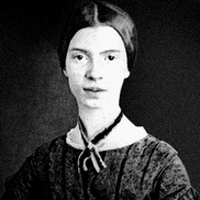Emily Dickinson - Biography and Works
Emily Dickinson a very sensitive lyrical poet was born in Amherst, Massachusetts, to a well-known family. For one year she attended Mount Holyoke Female Seminary (now College), in nearby South Hadley, then withdrew and returned to Amherst because she could not accept the Seminary’s rigid brand of Christianity and because she was home sick.

Emily Dickinson (1830-1886)
Her adult life was as short on external incident as it was long on imagination. Dickinson lived in her family home in Amherst from 1848 on, she rarely received visitors, and in her mature years she never went out. Though some biographers have characterized Dickenson as a frail, highly eccentric spinster, hiding from the world and frustrated in life and in love, the power of her poetry and the sheer amount of her literary contradicts such a picture. Suffering from agoraphobia (the fear of public places) and perhaps from an eye disorder called exotropia, she became known as the “Myth” and “the character of Amherst.”
Fewer than a dozen of her poems were published in her lifetime. Such a solitary life hardly dulled her sensibilities, however, for Dickinson’s collected works- nearly two thousand poems, plus voluminous correspondence – brim with intense feeling, from terror to joy. The poems also reveal her intimate knowledge of the Bible, classical myth, and the works of Shakespeare; in addition, she admired the work of Transcendentalists Thoreau and Emerson and read the Brontes, the Brownings, Keats, and George Eliot. In an era marked by its evangelical fervor, Dickinson adopted skepticism- though she did not arrive at it easily - and her poems are remarkable for their irony, ambiguity, paradox, and sardonic wit. She concisely defined her aesthetic in the epigrammatic lines “Tell the Truth but tell it slant--/ Success in Circuit lines,” and she once told a friend: “If I read a book (and) it makes my whole body so cold no fire ever can warm me I know that is poetry. If I feel physically as if the top of my head were taken off, I know that is poetry.” She wrote in the meters of hymns and made masterful use of the ballad stanza, often using slant rhyme. Although her innovations initially baffled critics, the public’s fascination with her life soon extended to her verse. Though the form of her poetry looks simple, with its patterns of meter and rhyme suggesting her use of nineteenth-century hymnals as models of prosody, there is nothing simplistic in what she says, and her unconventional punctuation forces us to pause with her thoughts as she examines faith and doubt, death, nature, and varieties of love. She is, along with Walt Whitman, the most revered and influential of nineteenth-century American poets.
Dickinson’s works are compressed, painstakingly crafted, and often experimental, using off-rhymes, varying rhythmic patterns, and unusual syntax. She confronted all themes – love, nature, beauty, sadness, death, immortality, religion- with a passion and lack of sentimentality that belied the popular image of her as a sensitive recluse. In the early stages of her career, Dickinson’s handwritten lyrics imitated the formalities of print, and her poetic techniques were conventional, but she later began to attend to the visual aspects of her work. For example, she arranged and broke lines of verse in highly unusual ways to underscore meaning and she created extravagantly shaped letters of the alphabet to emphasize or play with a poem’s sense. The eccentricities and technical irregularities which alarmed her early editors and reviewers include: frequent use of dashes; sporadic capitalization of nouns; convoluted and ungrammatical phrasing; off-rhymes; broken meters; bold, unconventional and often startling metaphors; and aphoristic wit. These have greatly influenced 20th century poets and contributed to Dickinson’s reputation as one the most innovative 19th century American poets.
Cite this Page!
Sharma, K.N. "Emily Dickinson - Biography and Works." BachelorandMaster, 9 Nov. 2013, bachelorandmaster.com/biography/emily-dickinson.html.
Related Topics
Much Madness is Divinest Sense: Analysis
Renunciation: Summary and Analysis
Because I could not Stop for Death: Analysis
I Heard a Fly Buzz: Summary and Analysis
After Great Pain, a Formal Feeling Comes: Analysis
Success is Counted Sweetest: Summary and Analysis
I taste a liquor never brewed: Summary and Analysis
A Bird came down the Walk: Summary and Analysis
Hope is the Thing with Feathers: Analysis
I like to see it lap the Miles: Summary and Analysis
I had something that I called mine: Analysis
If I should Die: Summary and Analysis
I'm Nobody! Who are you?: Summary and Analysis
These are the days when the Birds come back
What Inn is this: Summary and Analysis
Exultation is the going: Summary and Analysis
Of Bronze-and Blaze: Summary and Analysis
A Clock Stopped: Summary and Analysis
I felt a Funeral, in my Brain: Summary and Analysis
Safe in their Alabaster Chambers: Analysis
There's a certain Slant of light: Summary and Analysis
To fight aloud, is very brave: Summary and Analysis
I like a look of Agony: Summary and Analysis
Bring me the sunset in a cup: Summary and Analysis
The day came slow-till Five o'clock: Analysis
The Bustle in a House: Summary and Analysis
 |
bachelorandmaster.com |